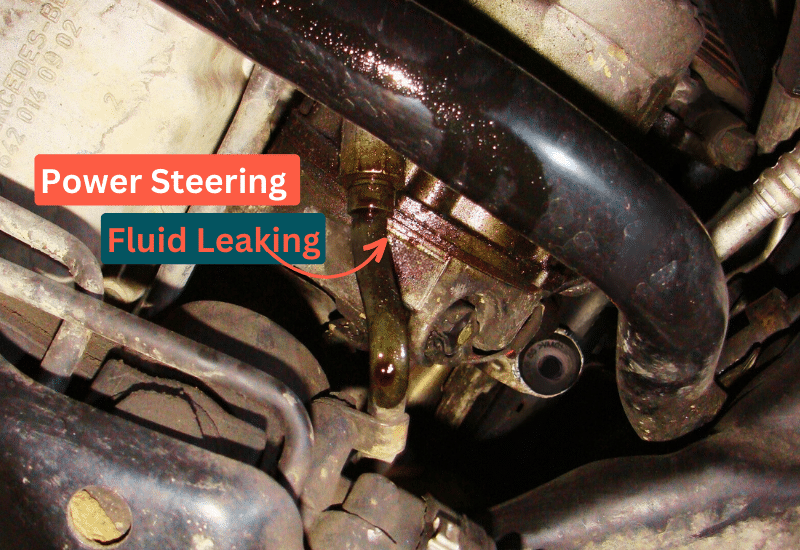
Power steering has made everyday drives a much easier experience. However, the hydraulic system that the power steering relies on can and does fail.
The leaks can occur in many places, usually on junctions, seals, and gaskets. However, a leak can also be on the pump or steering rack. Sometimes, it may be hard to locate the leak initially, especially if it is minor.
Some symptoms that a power steering fluid leak can cause include heavy steering, ranging from slightly heavier to extremely difficult to turn, a red fluid leaking from your car, and unusual sounds like grinding and whining when you turn the steering wheel. The cause can be as innocent as a worn-out seal, a damaged hose, or a leak on the steering rack itself. The sooner you stop the leaking, the better, as a lack of power steering fluid can further damage the power steering system.
In this article, you’ll find out what exactly causes a leak, which symptoms it causes, and how much money it will cost to fix this issue.
How Serious of a Problem Is a Power Steering Fluid Leak?
You may have noticed a strange red fluid after moving your car from a parking spot or perhaps heavy steering. So what? – you may be asking.
Initially, this may not be too bad. You’ll be able to drive almost as usual. However, a power steering fluid leak problem can quickly become a headache.
If your power steering is leaking, this can quickly become a severe issue. If the leak is under high pressure and the crack or hole through which the fluid is leaking is large, you may lose all of it in a few minutes. On the other hand, some leaks may only be noticeable when you lift the car or park it in one spot for some time.
The leak can pose a driving hazard, as turning the steering wheel is almost impossible. You should, therefore, get a power steering leak diagnosed and fixed as soon as possible since you can’t predict how fast it will leak out.
Another concern with continued driving despite a low fluid level is permanent damage to your power steering. You probably don’t want to take this risk since buying and replacing power steering parts can be costly.
5 Important Symptoms of a Power Steering Fluid Leak
Several telltale symptoms almost unambiguously point to a power steering leak. Still, symptoms such as heavy steering can have other causes.
1.A Red Fluid Leaking From the Car

The most definite sign is a reddish, oily fluid that you may see leaving a trail as you drive, as a puddle after leaving the parking lot. You may also see it when the car is lifted around the steering rack, power steering pump, or one of the hoses.
If you’re unsure of the fluid color, you can always check the levels of each fluid under your hood. The power steering fluid is appropriately marked, and you can check if the level is below the minimum.
2. Difficult Steering (Progressively Worse)

The most dangerous symptom of a power steering fluid leak is difficult steering. At first, when there’s still a significant amount of liquid left, you might notice only a minor difference. As more fluid leaks out, turning the steering wheel will require more and more force.
Eventually, if you ignore this long enough, you won’t be able to maneuver your car. This progression will be faster if the leak is from a huge hole or crack. It will virtually always keep getting worse, unlike with some other causes of difficult steering.
3. Low Steering Fluid, Even After Topping Up
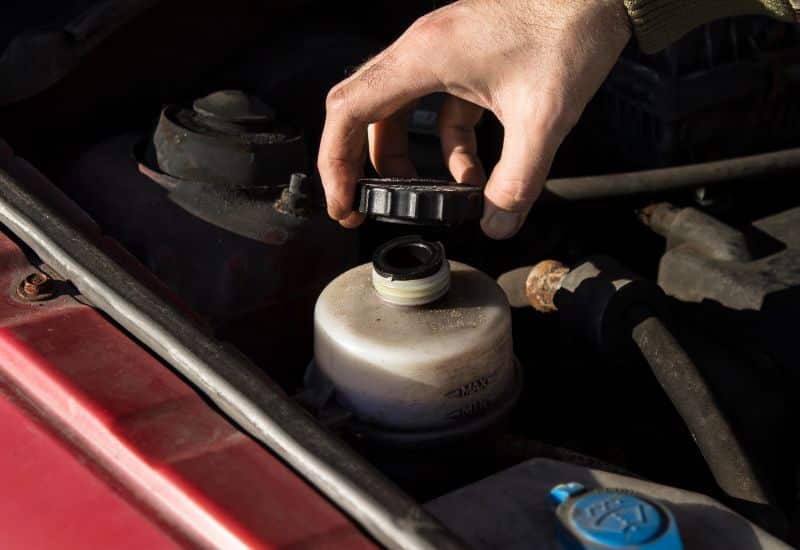
You can and should regularly check the steering fluid level, just like you check your oil. In case it’s below the minimum, you should top it up.
However, if you check it in a week after replenishing, and it’s below the minimum again, there are reasons for suspicion. Paired with the other symptoms, you’ll probably find a leak somewhere in the hydraulic system.
4. A Strange Sound While Steering

At first, this might throw you off. Hearing an unusual sound in your car can be scary. But fear not! If you hear whining, buzzing, or even shrieking while turning your steering wheel, it may be a lack of steering fluid from a leak.
A quiet buzzing sound is normal in a healthy power steering system. However, this is so quiet that you’ll likely not even pay attention when surrounded by other sounds. In other words, if the sound during steering is concerning, this can be a sign that your car’s steering system is leaking fluid.
5. A buzzing sound when turning on the ignition

On certain cars, in case of a leakage in the power steering system, you may hear an unusually loud buzzing sound when you turn on the ignition or after you start the car.
This sound arises when the power steering draws air into the hydraulics because there’s a leak somewhere. However, just because you don’t hear it doesn’t mean it’s not a power steering fluid leak. The more of these symptoms you notice, the higher the likelihood that this is your issue.
What Causes the Power Steering Fluid to Leak?
A leakage in power steering is more likely to occur in older cars. (Many newer cars have electric power steering.) Another cause for leaking, besides wear and tear, can be physical damage to the steering rack or a hose.
The most common culprits are:
How to Diagnose Leaking Fluid in Your Power Steering
Diagnosing a leak in the power steering symptoms is not difficult based on the symptoms. You should take the following steps:
1. Check Your Power Steering Fluid Level
Checking the fluid level is a simple and effective way to determine if the problem has anything to do with the power steering fluid in the first place.
2. Check for Leaking Fluid Under the Car
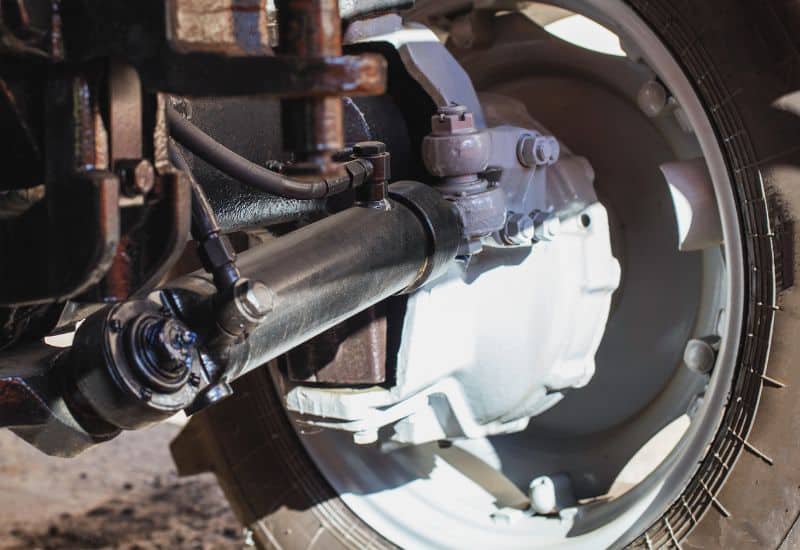
If the fluid is below the acceptable threshold, or you’ve noticed any symptoms mentioned here, you might want to confirm your suspicion by checking for leaked fluid.
You’ll most likely notice the fluid underneath the front end of your vehicle where the power steering is located.
You may also be able to see fluid on the steering rack or on nearby parts when the car is on a lift.
3. Pay Attention if the Fluid Level Changes
If your fluid level continuously drops after refilling, this may be a sign of leakage.
After making sure the fluid is near maximum, test the level again after some driving. If there is a significant difference, you likely have a leak. Take your car to a professional as soon as possible so they can determine the exact location of the leak and fix it.
How Do You Stop a Power Steering Leak?
Stopping a power steering leak will usually take some work. Patching parts up is not the best idea, nor is it foolproof. Replacing all the components where the leak is found will ensure that it’s stopped.
Most often, this means finding the exact location of the leak, such as a hose or seal. Sometimes, it may only be an old gasket. In case of a more crucial part, like the pump or the steering rack, you’ll likely have to replace the whole component.
Since power steering is crucial for driving, it’s best not to fiddle with it unless you know what you’re doing. A professional mechanic will easily spot where the leak is and do the replacements correctly.
How Much Does a Power Steering Leak Repair Cost?
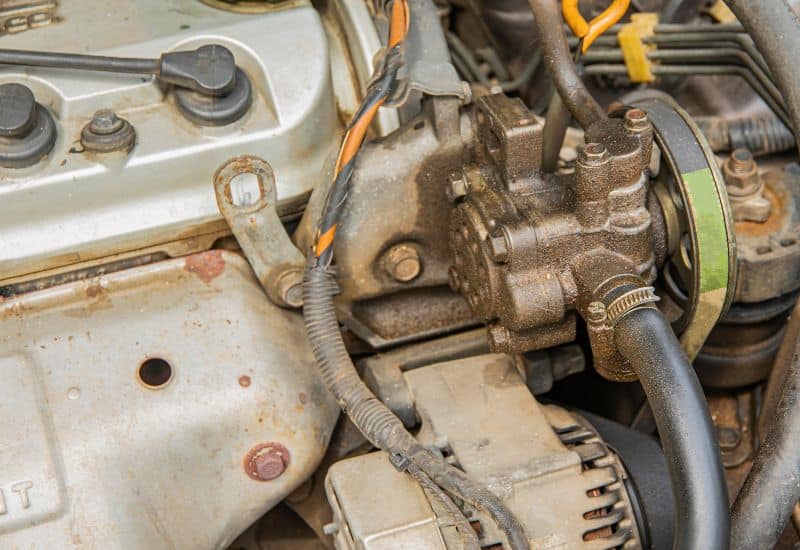
The cost of your power steering repair depends on the part that needs replacement, its location (since that dictates labor hours), the state you live in, and the particular shop.
Generally, the cheapest replacement will be a hose or a similar minor part. Hoses usually cost from 50 to 150 USD.
A steering rack and pinion cost more: they range from about 130 to upwards of 500 USD, plus the labor cost.
The worst possible scenario is replacing the whole power steering system, which takes a lot of time and many parts whose price adds up. It’s unlikely that this will cost less than 500 USD.
FAQs
Can you drive a car with a power steering fluid leak?
You might be able to drive your vehicle for a certain period without too much trouble. However, the decline can be rapid: if a crack or hole grows from wear, you might lose enough fluid in the middle of driving that you won’t be able to turn the steering wheel.
In any case, get your vehicle checked as soon as you notice any of the symptoms mentioned in this article, especially if the steering is so difficult that driving becomes dangerous.
Can My Power Steering Stop Leaking on Its Own?
If a leak has started in your car, it can only get worse. It will never stop on its own, though it can be tempting to keep driving if you only notice a small puddle under the car or can still easily steer.
However, if the damage to your power steering system worsens, the speed at which the fluid leaks may quickly skyrocket. This will lead to more severe symptoms and perhaps even more damage from driving without enough fluid.
How Often Should You Put Power Steering Fluid in Your Car?
The answer is not very often. While it’s typically around 80,000 miles, it’s best to rely on manufacturer specifications for your vehicle model.
Even if you don’t notice symptoms now, it’s important to occasionally replace and top up the fluid to avoid any potential problems. However, this is still not something you’re supposed to do every month or week if there is no leak.
Conclusion
A power steering fluid leak is likely not the most common car fault you’ll come across, but its symptoms are recognizable even without a diagnostic tool. It’s crucial to have this fault checked before it progresses to a total steering failure.
After a basic inspection, such as looking for a puddle of fluid under your car and checking the fluid level, you’ll have more info for your mechanic about the potential cause. They will then replace the part or parts at fault to ensure nothing is leaking. You can expect the range of most fixes to be in the triple digits, while a full power steering replacement will not cost you below half a grand.

Written By
Jason Farrell
Jason Farrell is a certified master technician, the editor of Mechanic’s Diary in Pittsburgh, Pennsylvania. He is ASE (Automotive Service Excellence) certified and earned a Bachelor’s Degree in Automotive Technology from Pittsburg State University. With nearly 18 prior years of experience in the automotive field, he has extensive knowledge about Domestic, European, and other foreign makes and models of cars and light trucks. Jason’s experience working as a technician and service manager at dealerships, gave him the experience and know-how of most aspects of inspection, diagnosis, and repair from engine and drivability to electrical, HVAC, brakes, steering and suspension and everything in between.

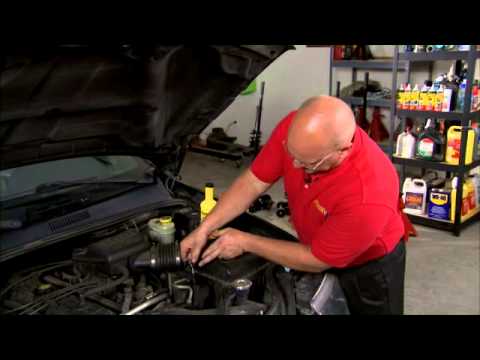
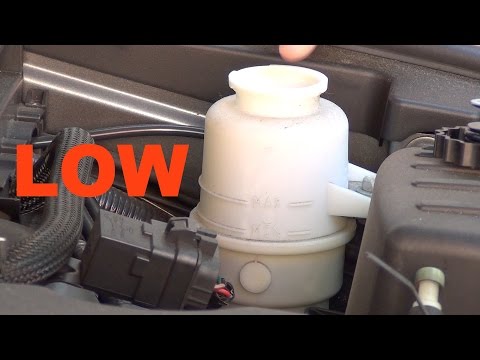
Thanks for sharing, Nice one, this is informative